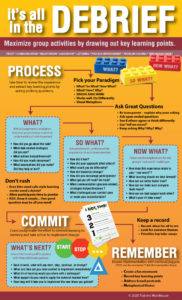Perfect DEBRIEFS for Any Learning Game
Let’s say you find the perfect learning game—for communication, listening, negotiation, leadership, process improvement, problem solving, critical thinking, and time management—then what? Games work because they remove players from their usual setting and create a safe environment to take risks and try new approaches. But, playing the game isn’t enough. Behavioral change relies on a debrief that draws out “ah-ha” moments and applies those to real-world challenges. Get the most out of your learning game by using this Debrief Infographic. The graphic is chock full of tips and processing questions to help you conduct the perfect debrief.
The graphic divides the debriefing process into three parts: 1) Process and discuss the experience; 2) Commit and plan next steps; and 3) Remember and take action.
Process
Consider “process” as both a verb and a noun. The core of a debriefing exercise entails taking time to actively process the experience – consider what happened, how you felt about it, and what you learned from it. The process you use to do that can take a variety of forms, but the key to each is asking good questions.
- What? So What? Now What?
The focus of these questions is: What have you learned? So what, what is the significance of the learning? Now what are you going to do or change going forward? - Works Well. Do Differently.
With these two simple questions, facilitators can help their groups to explore what was working and where they can do better. The key is that it frames this self-critical exercise in positive, non-threatening terms. - WHOA! AHA! HMM!
Perhaps simplest of all, you can ask your group to share their “aha” moments. Or, make it even more fun by adding WHOA! (what surprised you?) and HMM! (what made you ponder?).
No matter what questioning paradigm you choose, facilitators are well-advised to adhere to these six tips:
- Be transparent – explain what you hope to achieve by asking questions and debriefing the experience
- Keep it simple – make questions short, pithy, and easy to answer
- Foster conversation – ask open-ended questions and inquire whether others agreed or think differently
- Probe for more – keep asking “why?” or say, “Tell me more,” to better understand participants’ experiences.
- Don’t rush – give participants time to think through the experience and answer your questions thoughtfully
- Write it down – record ideas that are shared so your group can focus their thoughts on listening and formulating their own answers
Crafting your questions
When it comes to finding the perfect question(s) to ask, we’ve found these to work quite well in a variety of situations, but of course, every facilitator should adapt the recommendations to the needs of their group, exercise, and goals.
What? Questions
Without judgment or evaluation, help your group develop a common understanding of what happened. Sometimes individuals lend different meanings, or draw different conclusions, from events that occurred or words that were spoken. Help your group distinguish “what happened” from any interpretations assigned to them. By developing a shared framework, you will help the group avoid miscommunication and misunderstandings. In that spirit, ask:
- What happened?
- How did you go about the task?
- What task-related strategies did you use?
- What actions helped/hindered?
- How did you reach a consensus?
So What? Questions
Ask questions to understand the experience of each team member. So What? questions get more to the nuance of how participants experienced the learning activity. The goal at this stage is to understand more about how participants felt, the effectiveness of their different strategies, and the relevance of choosing one strategy over another. You might ask:
- How did it feel?
- How did your approach affect others?
- What would you do differently?
- How did leader(s) emerge?
- How did you encourage participation?
- What got you off track? On track?
- What assumptions did you make? Did they help or hurt?
- What communication (process-related) strategies helped/hindered?
- What challenged your comfort zone or made you uncomfortable?
Now What? Questions
Now What? questions are the first step in teasing out the implications of the simulated activity on the group’s “real world” challenges. While the benefit of simulated exercises, games, and activities is precisely to remove players from their real-world situations, the end goal is to come full circle and apply the introspection and learning back to day-to-day realities. Facilitators can ask, simply:
- How does this experience relate to your “real world”?
- What learning should we take forward?
- How can we better foster trust?
- How can we make sure everyone feels heard?
- How can we best support each other?
- What is your #1 take-away?
 Commit
Commit
The prior “now what?” questions may uncover the important learning points, but they don’t ensure behavior change. They don’t make certain that learning will be applied. The commitment phase, therefore, helps facilitators guide participants into taking action and pledging to take next steps. These final questions may help:
- Back at work, what will you start, stop, continue, or change?
- What one idea are you most excited to implement immediately?
- What bit of learning would you share with a colleague?
- What support do you need to apply the material learned here?
- How long will it take you to implement the new ideas you gained?
Remember
As a final step, facilitators will want their group to remember what they learned and to actually do what they said they’d do. The mnemonic C.R.A.M. will help facilitators remember what some of their options are:
C-Create a fun mnemonic (have participants work in teams to come up with something to jog their memories)
R-Record key learning points (ask participants to write down their next steps in an app or document they frequently use)
A-Address and mail a postcard (you can do this, or your participants can)
M-Metaphorical photos (have each person select a photographic image that will remind them of their key takeaway)
Wrapping it up
Facilitators and managers know as well, or better than their group that activities are a waste of time if behaviors don’t change as a result of the experiences. Debriefs don’t have to long, but they must happen. Trainers Warehouse offers additional tools and resources to make the debrief as fun and effective as the learning game itself, including Start-Stop-Continue-Change Sticky Notes, Photographic Card Decks, I-Got-This or “Hindsight-is-20/20 notepads,” Squeeze Toys, and more.
Read more:


